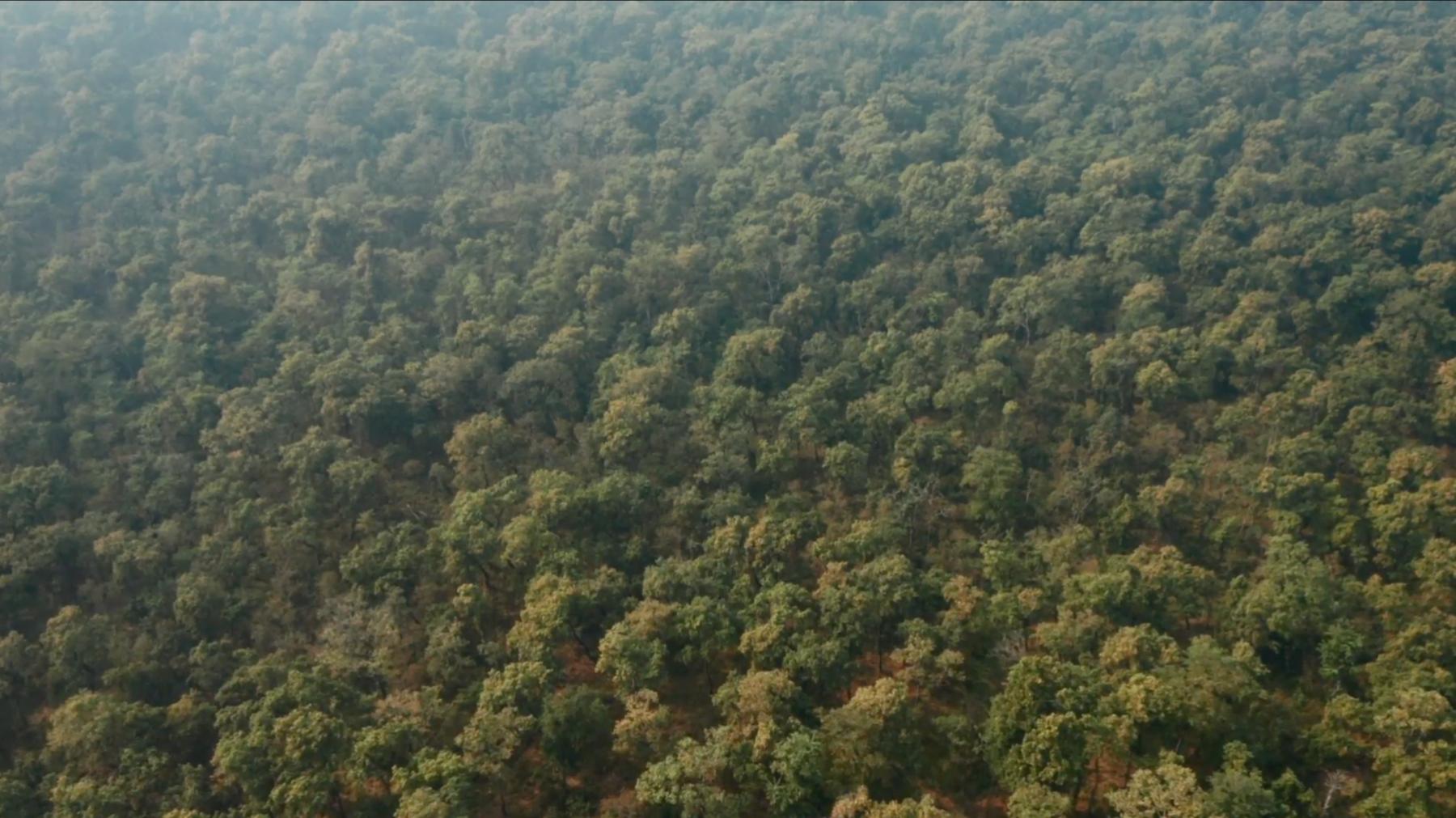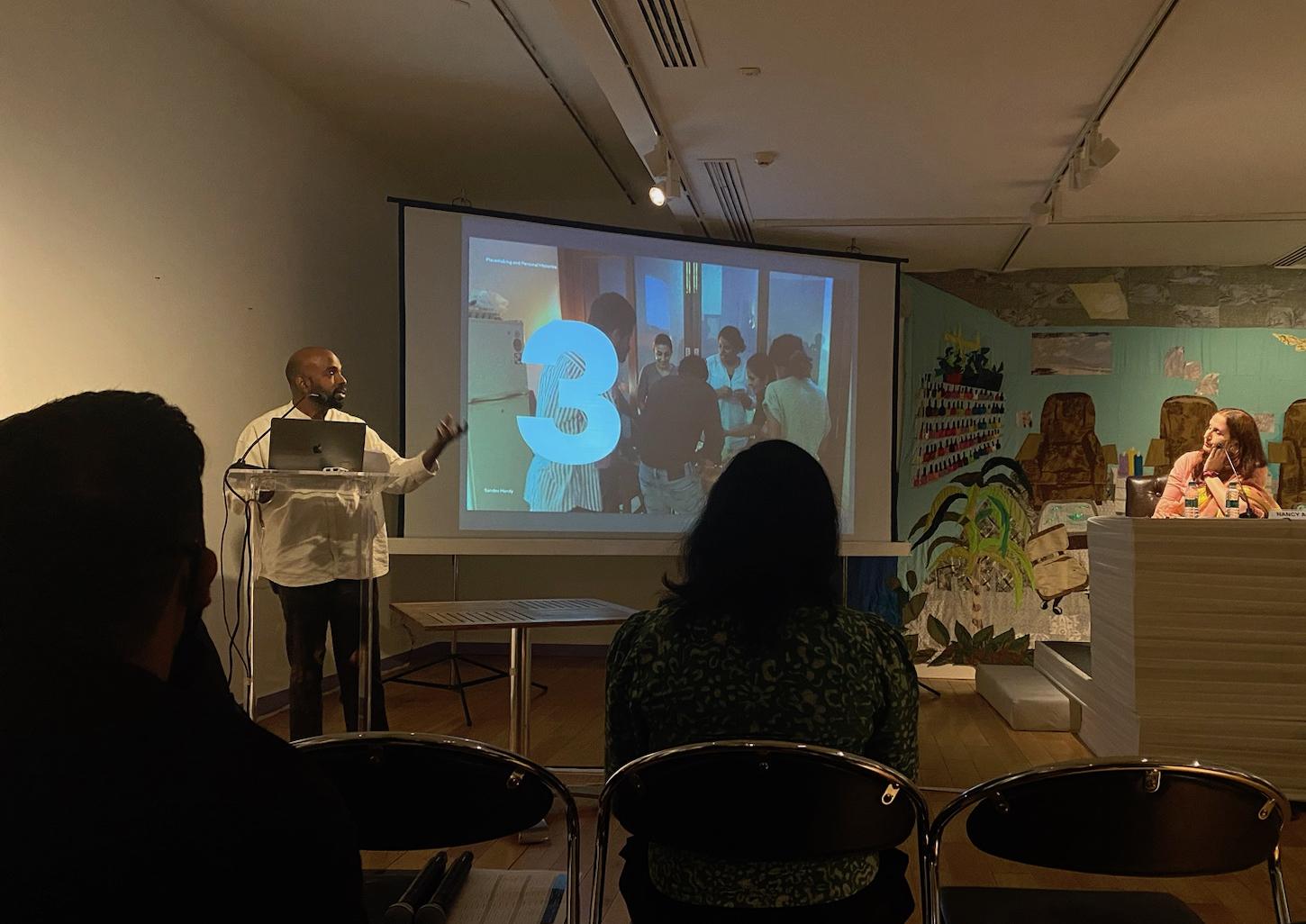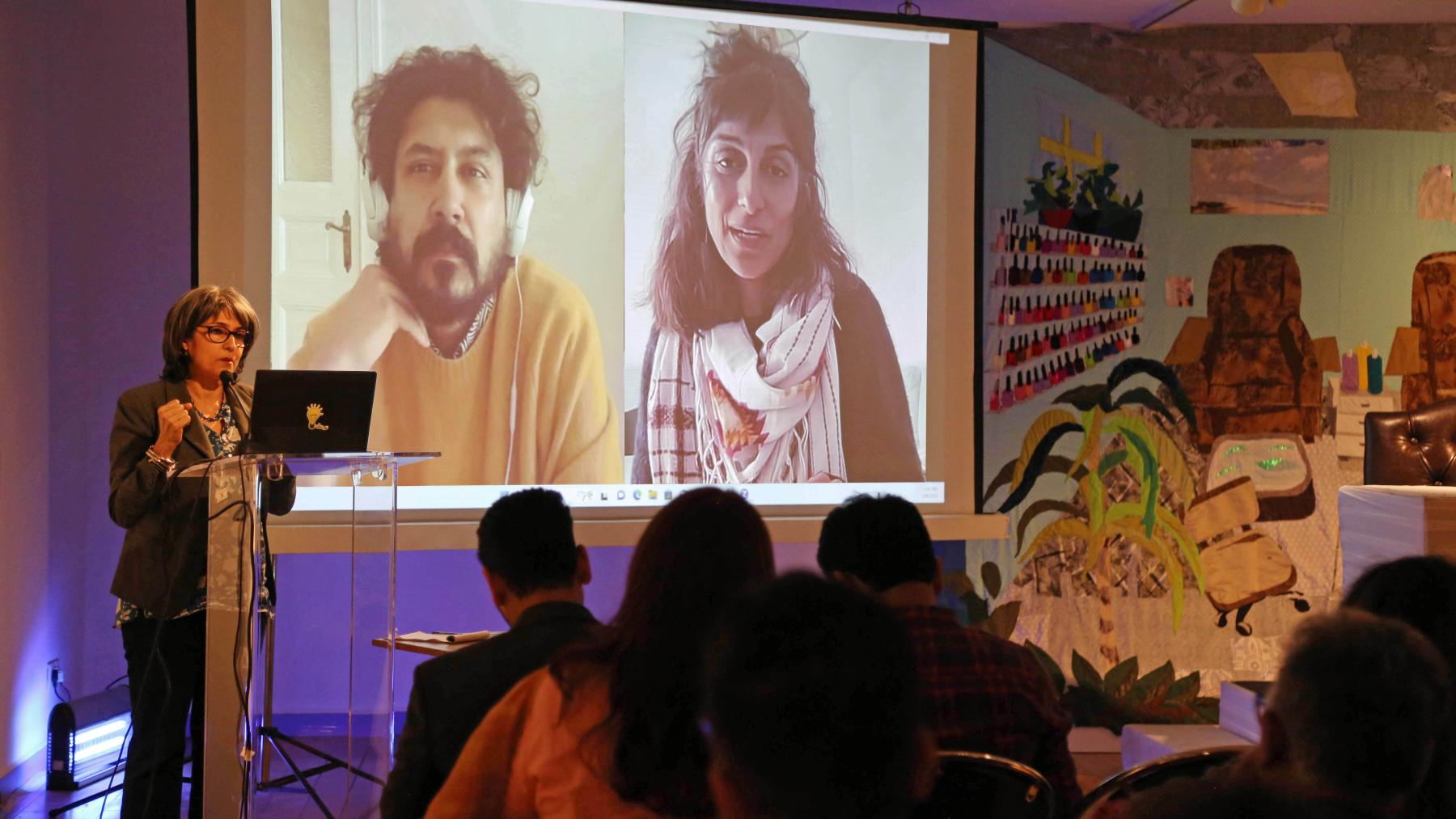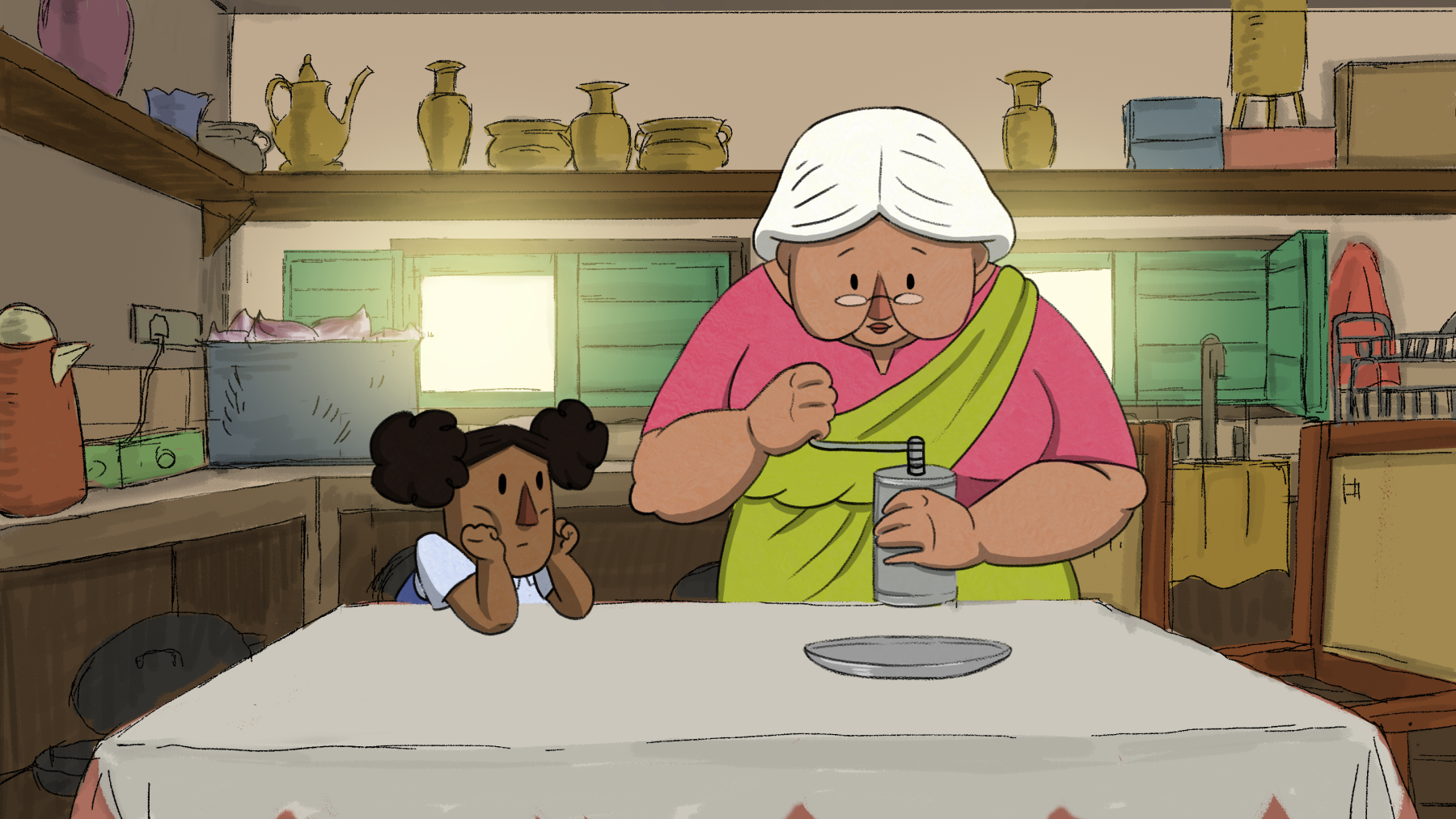Space, Placemaking and Belonging: Shaping South Asia
Organised by the Kiran Nadar Museum of Art (KNMA) and the Alkazi Foundation for the Arts, Imaging South Asia was held in Delhi on 8 April 2023. The symposium fostered a spirit of sharing ideas, propositions and provocations on our shared subcontinental identity through practice. A crucial node of the symposium considered questions of site, place, spatiality, boundaries and territoriality. Inquiries into these dominated the second half of the day, with panels on “Placemaking and Personal History” and “Diaspora and Postcoloniality.” The former comprised presentations by Diwas Raja Kc, Sandev Handy and Farah Mulla, moderated by Nancy Adajania. The latter was moderated by Prof Sabeena Gadihoke and consisted of presentations by Tanzim Wahab and Jeanno Gaussi.

The panel "Placemaking and Personal History" included presentations by Nancy Adajania, Diwas Raja KC, Farah Mulla and Sandev Handy. (Imaging South Asia, KNMA, Saket, 8 April 2023.)
Nancy Adajania proposed two thematics for approaching practices of representation: critical emplacement and a fusion of horizons. Critical emplacement implies that artists position themselves responsibly in locations within or outside their own society, recognising that it is imperative to engage with the history of that side in order to forge new social relationships and interdisciplinary accounts. This enables a destabilisation as well as constant renewal of the frameworks for making, viewing and sharing. Borrowing from Hans-Goerg Gadamer’s understanding of fusion of horizons, Adajania spoke about her first film Khichri Ek Khoj (1999). In a clip from the film, Gopi, a woman from a marginalised community, tells the story of a tiger and a crab. A parable about hospitality and hostility that extends to the ethics of intervention, the narrative is punctured by gaps and silences. The ending is ultimately forgotten as Gopi attempts to tell the story in a language that is not her mother tongue. This narrative act for Adajania is an example of Antonio Gramsci’s organic intellectual, who makes counterhegemonic assertions by suggesting a new political and cultural imaginary.

Screengrab from Nepal Picture Library's The Skin of Chitwan website.
Interrogating place in the context of region, Diwas Raja Kc spoke about Nepal Picture Library’s The Skin of Chitwan. The project archives a history of the Chitwan forest and its peoples as well its state today as a frontier zone. Referencing Rob Nixon’s idea of “slow violence” as delayed destruction that is dispersed across time and space, Raja highlighted the way in which this sustained violence has insidiously invaded the structures of memory in the context of Chitwan. Increased surveillance in the Chitwan National Park has altered access to what was earlier a commons. Looking at the history of the Tharu people, Raja argued that it might be worthwhile to remember that South Asia once comprised of pockets of empires, separated by vast tracts governed by local confederacies, and therefore consider the productive possibilities of understanding South Asia through these in-between places. He concluded by reiterating that indigeneity as a form of placemaking is among the most profound legacies of our lands.

Translat, All of the Above, None of the Above. (Farah Mulla. Melahuset, Oslo, 2017.)
Farah Mulla examined the technological, psychological and neurological aspects of sonic landscapes and their politically charged nature. In a particularly interesting work, Mulla spoke about the relationship between belonging, place and sound. Responding to migrants seeking sanctuary in Oslo, Mulla evolved the project Translat in 2017. Taking the form of sonic graffiti, the work sought to understand the different reasons that lead people to migrate. QR codes were disseminated all over Oslo in an attempt to re-humanise migrants by giving their stories a voice. They described landscapes or sounds from their memories but did not mention the names of the places. The work highlighted how sounds can reveal or conceal a person’s identity, leaving people to reflect on notions of travel, space and what makes a place home.

Sandev Handy presenting at Imaging South Asia. (Photo by Abdul Halik Azeez. Delhi, 8 April 2023.)
Speaking from the binary position of working in an institutional space and having a personal anti-institutional art practice, Sandev Handy presented several vignettes. He first elaborated on the Museum of Modern and Contemporary Art, Sri Lanka, as a case study. An interesting thread that emerged for one of their exhibitions was of the Afro-Asian Writers’ Association, parallel to the Non-Aligned Movement. Formed in 1958, the association championed anticolonial struggles from a literary and cultural standpoint. Handy traced the origins of their trilingual quarterly journal, Lotus Magazine, to discover that it did not begin in Ceylon; but had emerged as a result of the politics of the Cold War. Examining the content of similar journals from this period, Handy highlighted the failures of counter worldmaking by these publications. Many ignored the complex politics of violence and oppression in their own country while making statements on the plight of other countries. In trying to unpack some of these ideas, Handy looked to his personal practice in the present as a process of collective thinking that focuses on hyper-locality. His collective, The Packet, works from a place of centring friendship as a methodological approach to counter institutional forms of placemaking through intimacy and play.

The panel "Diaspora and Postcoloniality" consisted of presentations by Prof Sabeena Gadihoke, Tanzim Wahab and Jeanno Gaussi. (Imaging South Asia, KNMA, Saket, 8 April 2023. Image courtesy of The Alkazi Foundation for the Arts.)
Sabeena Gadihoke spoke about imaging practices that emerged across South Asia as a consequence of postcoloniality. She pointed to the expansion of South Asia not just through physical travel, but also through journeys made in the minds of the diaspora. Taking the example of Sandhya Suri’s I For India (2005), Gadihoke commented on how migration and movement are marked by nostalgia and longing as well as new forms of memory making. The film uses home footage in the form of video letters to explore the act of looking back from the outside. She also showed clips from Project Daastan’s film Sea Birds (2022) to frame an embodied experience of South Asia for the diaspora. The idea of home is invoked not just through the image but also through other senses like smell, touch, sound and taste.

Nithya watching her grandmother, Umayal, make string hoppers. (Screenshot from Sea Birds, part of Project Dastaan: Lost Migrations [2022]. Image courtesy of Sawera Jahan.)
Tanzim Wahab spoke about diasporic solidarity against human rights violations in Bangladesh. This resulted in collaborative formats across diverse contexts in his curatorial practice. One such example is Bor-Porong (2021), made during the pandemic with lawyer and activist Samari Chakma and artist Naeem Mohaiemen. Their collaboration involved discussing and reading from Chakma’s book Kaptai Badh: Bor Porong. It collects oral history narratives of the Chakma people who were exiled by the drowning of Pahari villages in the 1960s as a result of the Kaptai Hydroelectric Dam Project. Seeking to emphasise the lack of a tangible anchor to this moment in history, acts of reading and translation over the internet enabled a flattening of space, allowing complex layers of time to be unearthed.
Jeanno Gaussi spoke about her collaborative practice as it enabled her to engage with memories of her home country, Afghanistan. Working with traditional artisans from Afghanistan, India and Pakistan, she sought to create new forms of objects through dialogue. Her work, Dreams on Wheels, involves the painting of skateboards, an object Gaussi was intimately familiar with, borrowing from the aesthetic of truck painting in Pakistan and India. The project evolved from her conversations with various people from Afghanistan about their dreams. A significant example from this project was of Mother Mary, who appeared in the dream of one of the subjects, and was then translated onto the skateboard by Ustad Abdullah.
Dreams on Wheels_Kabul, 2013 and Dreams on Wheels_Delhi, 2015 at Pop South Asia, KNMA. (Jeanno Gaussi. Acrylic paint on wood and embossed iron. Painted by Ustad Abdullah, commissioned by Jeanno Gaussi.)
Exploring degrees of belonging and placemaking through recollection, resistance and solidarity, the symposium provided a platform for sharing some of the experiences that shape our understanding of South Asia. The various invocations of space in this context were highlighted by the mise-en-scene of the symposium. Chairs for the audience and a podium and table for the speakers were set up in the midst of the museum hall, with works from the exhibition materially grounding those present in the dialogue being generated. As a largely in-person event, the symposium offered a space of conviviality and an intimate exchange of ideas. It is perhaps fitting that the embroidered work “Sahar, Nail Salon #1” (2020) by Hungama Amiri framed the panellists, as the space of the hall transformed into a salon for sharing the possibilities of imaging South Asia.
Read Mallika Visvanathan’s piece on the panel on new media from the symposium.




